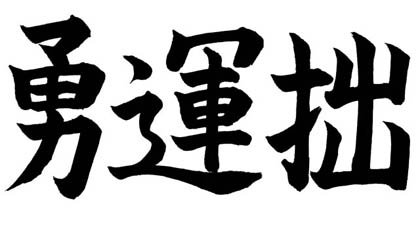Iaido shinsain no me – The eyes of the Iaido judges
 In our last post 5 days in Japan I wrote that during our last trip in Japan we made some shopping just before departure. In our shopping bag there were a series of DVD but also a new book called “Iaido shinsahin no me”. This book edited by the “Kendo Jidai” publisher is a compilation of 15x ZNKR 8th Dan Hanshi sensei’s opinions on what are the important points needed for shinsa, embu and taikai. It is of course written in Japanese and will probably not be translated, so we decided to start a very rough translation of some parts. The book is separated into fifteen parts, one for each sensei and each part separated into a 2 points and three chapters …
In our last post 5 days in Japan I wrote that during our last trip in Japan we made some shopping just before departure. In our shopping bag there were a series of DVD but also a new book called “Iaido shinsahin no me”. This book edited by the “Kendo Jidai” publisher is a compilation of 15x ZNKR 8th Dan Hanshi sensei’s opinions on what are the important points needed for shinsa, embu and taikai. It is of course written in Japanese and will probably not be translated, so we decided to start a very rough translation of some parts. The book is separated into fifteen parts, one for each sensei and each part separated into a 2 points and three chapters …
* Please bare in mind that we are no professional translators and that our translation may and probably will contain errors. The translation will not be word for word and will be only done to give a general idea of the content.
Let’s start with the contents:
1. Ueno Satanori (p11)
* Iaido’s life is expressed in the nukitsuke and kiritsuke
* Is the embu done with 100% body and spirit/soul
+ Sitting without blinking eyes and focusing on the target to reach
+ Is the Kissaki following the correct path during the nukitsuke and kiritsuke
+ Iaido is “See and cut an invisible opponent”
2. Kishimoto Chihiro (p23)
* Importance of the kiseme until the nukitsuke
* Creation of the “ma” allows the emergence of the Kasso teki
+ Is the riai of the the kata respected
+ Is the body/attitude ready/correct before action
+ The day to day attitude is revealed during an examination
3. Masumine Tatsuo (p33)
* The importance of the ring finger and auricular of the right hand
* The solid grip of the tsuka during the nukitsuke
+ The kan-kyu breathing give birth to the waza kan-kyu (kan-kyu=speed variation)
+ The auricular can not be gripping the tsuka when starting the tegake
+ The right footwork usage give birth to fukaku
4. Takeda Kyofusa (p45)
* Performing nukitsuke with the kasso teki awareness
* Does the embu renders the waza riai reality
+ Is there a solid knowledge of the ZKR Iai Book
+ Is there Jo-Ha-Kyu in the waza
+ An Iaido that cuts and is sharp is a logical Iaido
5. Yamazaki Masahiro (p57)
* Importance of assimilating the waza with the body and then adding spirit to it
* Performing the nukitsuke without moving the body center line
+ Does the embu have depth
+ Stabilize the body balance creating an isosceles triangle
+ Is there a dialog with the teki
6. Kobayashi Tadao (p71)
* Master/assimilate the technique with the body to ensure fluid movement
* Is the nukitsuke performed because of the enemy attack
+ Is the personal training/personality revealed/inserted into the practice
+ Is the saya banare correctly performed
+ If the cuts is done “Futsui” the waza become clear (Futsui is the sound made when a string breaks under heavy tension)
7. Yasunaga Tsuyoshi (p81)
* Koshi. Feet. Hands. together
* The whole embu in one flow
+ Is the left hand entirely covering the koiguchi during the tegake
+ If you want to end something … You have to finish it …
+ It is important to believe in yourself while doing an embu
8. Yamasaki Takashige (p95)
* The Kasou teki awareness is appearing by using the right timing and space
* Do not neglect saho
+ Neglecting breathing – Kokyu – is confusing your hearth. The importance of breathing with the hara
+ Create an invisible silk string link with the shinsa
+ Is there a conscience of one’s contribution to the society in the shuren (discipline in training)
9. Kawaguchi Tochihiko (p107)
* The skill is budo not dance
* Kirioshi should not be performed like scratching the ceiling but rather sweeping it.
+ Is there a spirit preparation as strong as the shinsain spirits
+ Does the eyes captured the kasso teki presence
+ The five points for high grades: Mushin, Budo, visible KanKyu Kyojaku / Johakyu, Strength removed from shoulder, No unforgivable mistakes
10. Sakono Yasuo (p117)
* Acquire your own maai, breathing and zanshin
* If the waza is done with bright personality one’s eyes will be captivated
+ Is the seiza position perfect
+ Reflect on each movement one by one
+ Is the riai the foundation of the waza
11. Ogura Noboru (p127)
* Standing, sitting or walking must have Iaigoshi
* Kirioroshi is clear when performed with the fingerprint
+ Is Furikaburi performed with the idea of a backward tsuki
+ The backward movement of the foot after chiburi must be a seme
+ Improve concentration by performing waza in the dark
12. Saeki Takaharu (p139)
* Always practice with an understanding of the enemy state (spirit, position, speed)
* An iaido giving the feeling of reality is required
+ Iaido is an exchange of life. Blinking is death
+ Take care of your standing position on the starting line
+ We look there in the ZenKenRen Iai
13. Ishido Shizufumi (p151)
* Is “2ku, 3ke” done
* Learn the loyalty to “shû”
+ Everyday life equal iai
+ Do you practise with the awareness of the maai
+ Preparation to the 10 points for 8dan shinsa
14. Watanabe Hideo (p163)
* The accumulation of a right keiko appears
* Are you cutting with your body weight on the monouchi
+ A katana is not to swing (huru) but to cut
+ It is satisfying if the enbu shows the kasouteki to the shinsain
+ Build an open-minded, big iai
15. Mitani Teruo (p173)
* The extraordinary of nukitsuke is in the second of sayabanare
* Learn the premonition and riai by kendo no kata keiko
+ Is there an expression of a fight swallowing the space
+ The power of the sayabanare instant is given by the left hand sayabiki
+ Are you fighting with an observating metsuke
No doubt the content of this book looks promising. It contains great subjects and check points for higher grades. We will try to start rough translation of some of the above chapters as soon as possible.
Y. & M.
BYK translations:
– Kawaguchi sensei
– Ueno sensei
For more translations please check the BKA website:
– Ishido sensei
– Kawaguchi sensei
– Kishimoto sensei
** This book has been published by Taiiku and Sports Co. http://www/taiiku-sports.co.jp and it is with its kind permission and the generous efforts of the translators that theses articles are provided to all for free circulation.
Please note:
1. These essays are the property of Taiiku and Sports Publishing Co. who have kindly allowed them to be freely distributed.
2. They may be copied but must remain in the format shown.
3. The articles may be not be sold or used in any way for financial gain.
4. The articles may not be altered without express permission of the publisher. **
Posted: May 6th, 2010 under Iaido, News.
Tags: Judge, Shinsa, Shinsain no me



